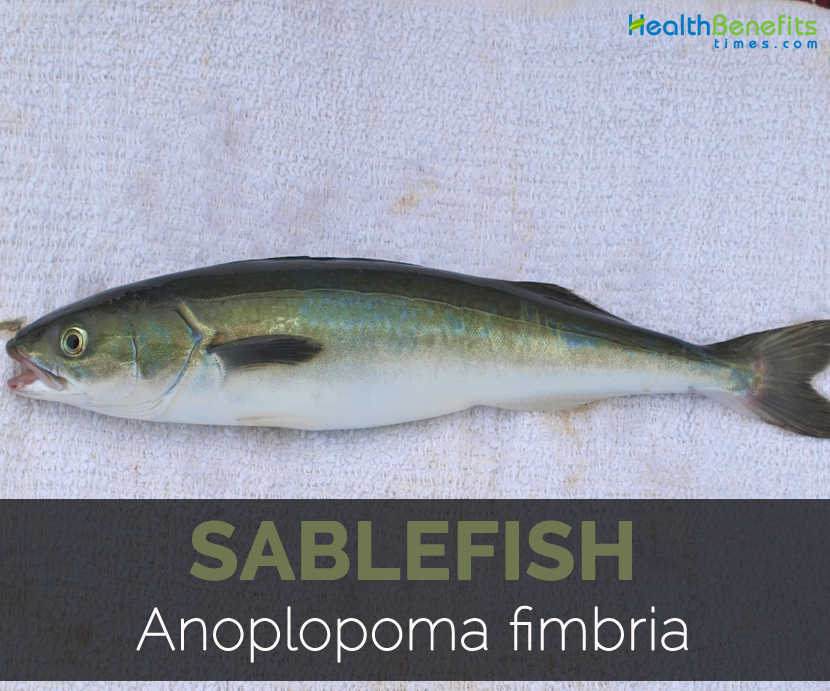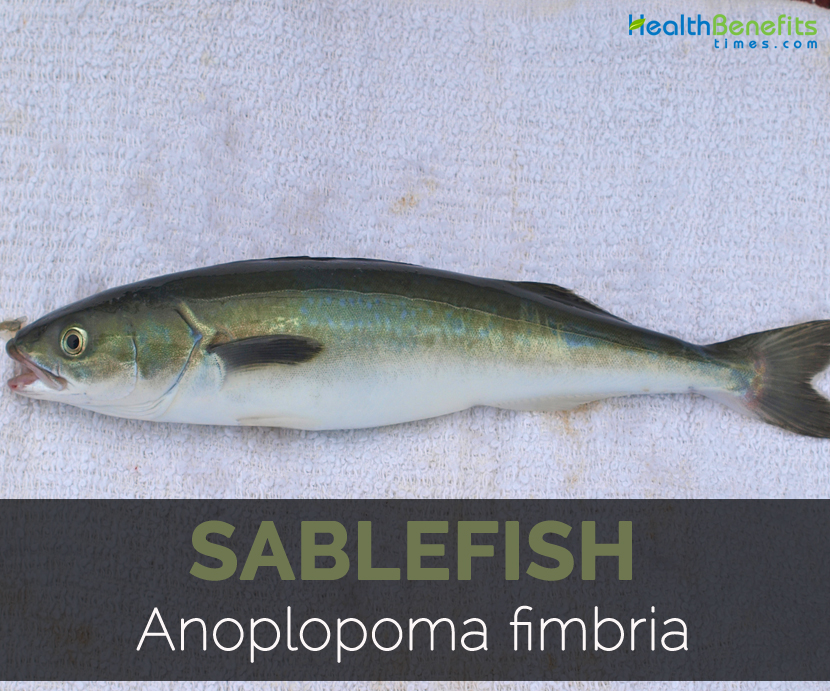| Sablefish facts and health benefits Quick Facts | |
|---|---|
| Name: | Sablefish facts and health benefits |
| Scientific Name: | Anoplopoma fimbria |
| Origin | Sablefish is available in Eastern Pacific (from Southern California to Bering Sea) and Western Pacific (from Kamchatka and Russia to Southern Japan). It resides in muddy areas in the depth of 1000 to 9000 ft. deep. |
| Colors | Dark gray to green |
| Shapes | Long, sleek, elongate; Length: 100 cm (30 inches) |
| Flesh colors | White |
| Calories | 212 Kcal./cup |
| Major nutrients | Selenium (72.36%) Vitamin B-12 (50.83%) Total Fat (47.66%) Isoleucine (40.25%) Lysine (40.13%) |
| Health benefits | Maintain cells, Strengthen immunity, Support digestion, Bone health, Enhance metabolism |
| More facts about Sablefish facts and health benefits | |
Sablefish is a fish having long, sleek and elongate body of 100 cm (30 inches) in length. It usually measures upto 10 pounds. It has dark gray to green skin with dark brown, black or gray scales and white flesh. The eggs laid are smooth, pelagic and 2 mm in diameter. When cooked, it provides unique and buttery flavor. It is loaded with amino acids, fatty acids, vitamins and minerals.
Nutritional value
In 85 grams of cooked Sablefish, it provides 53.42 grams of moisture, 212 calories, 14.61 grams of protein, 16.68 grams of total lipid fat and 1.15 grams of ash. It also provides the minerals such as 38 mg of Calcium, 1.39 mg of Iron, 60 mg of Magnesium, 183 mg of Phosphorus, 390 mg of Potassium, 61 mg of Sodium, 0.35 mg of Zinc, 0.024 mg of Copper, 0.016 mg of Manganese and 39.8 µg of Selenium.
Health Benefits of Sablefish
Sablefish is the fish species of genus Anoplopoma with the common names such as candlefish, coalfish, coal cod, beshow, bluefish, skil, blue cod, gindara and black cod. It preys on jelly fish, squid and small fishes. It has long lifespan upto 94 years. In Japan, it is vital and used as essential element for sushi. It has high content of fat and added to diet in forms of frying, steak, smoking, broiling, baking and grilling.
- Maintain cells
Vitamin is essential for the maintenance of cells in the body. It assists in the functions such as repair, formation and maintains red blood cells. It also helps to maintain the nervous system. (1)
- Strengthen immunity
Protein is essential for the immune health. The self-defense activity prevents the body from diseases and infection. The antibodies eliminate and deactivate foreign elements such as antigens. (2)
- Support digestion
Vitamin B3 assist in the functions of digestive health, nerve function, healthy appetite and skin health. (3)
- Bone health
Phosphorus is essential for the growth and teeth or bone health. It promotes the enamel of tooth and gum health. It provides relief from the health conditions such as osteoporosis. It ensures the health of skeletal structure. The study shows that it is associated with heart health and prevents the cardiovascular problems. (4) (5)
- Enhance metabolism
Pyridoxine helps to metabolize the nutrients for the extraction of energy. It is also essential for the metabolism of carbohydrates, vitamins, fats and amino acids. (6)
- Brain health
Iron is vital for the brain development. It aids the supply of oxygen to the brain as it uses 20% of oxygen. Iron is associated with brain functions and its health. It promotes the cognitive action and formation of neural pathways that helps to prevent from Alzheimer’s disease and dementia. (7)
- Reduce stress
Pantothenic acid helps to lower stress and mental problems such as depression and anxiety that promotes the mind fitness. It regulates hormones that cause these mental problems. (8)
- Cure cramps
Magnesium helps to soothe kidney stress, back muscles and muscular tension. It assists the calcium absorption that helps to heal bones. Its deficiency causes the leg cramps. The adequate intake of magnesium helps to treat the chronic leg cramps. (9)
- Eye health
Vitamin A is essential for the vision health. It helps to prevent dry eyes and assist in forming visual purple in eyes. It promotes the retina health and prevents night blindness. It reduces the chances of macular degeneration and cataracts. It is helpful for the glaucoma patients and promotes eye health. (10)
Precautions
- It should be consumed in limited amounts.
- The allergic people should avoid it.
How to Eat
- The flesh is baked, broiled, poached, grilled and pan-fried.
- It is dried, salted and smoked.
Sablefish facts
Sablefish is also called butterfish due to its rich and buttery flavor. It could be found upto 5000 feet (1500 metres). They have dark green to grayish body having white or pale grey belly. The body has got small scales which make it furry to touch. It has long lifespan and could live upto 90 years old. The average female gets mature in three or five years. They are predators that feed on squid, small fishes and jelly fish.
| Name | Sablefish facts and health benefits |
|---|---|
| Scientific Name | Sablefish is available in Eastern Pacific (from Southern California to Bering Sea) and Western Pacific (from Kamchatka and Russia to Southern Japan). It resides in muddy areas in the depth of 1000 to 9000 ft. deep. |
| Common/English Name | Sable, butterfish, black cod, blue cod, bluefish, candlefish, coal cod, coalfish, beshow, skil, alaska cod, skilfish, gindara |
| Name in Other Languages | Japan: Gindara; French: Morue charbonnière; Italian: Merluzzo dell’Alaska; German: Kohlenfisch; Spanish: Bacalao negro; Japanese: Gindara |
| Lifespan | 94 years |
| Predators | Salmon, Sperm whales, Pacific halibut, Orcas |
| Diet | Fish, invertebrates, squid, small fishes and jelly fish |
| Shape & size | Long, sleek, elongate; Length: 100 cm (30 inches) |
| Weight | 10 pounds |
| Scales | Dark brown, black or gray |
| Color | Dark gray to green |
| Flesh color | White |
| Flavor/aroma | Unique and buttery |
| Egg | Smooth, pelagic; Diameter: 2 mm |
| Major Nutritions | Selenium, Se 39.8 µg (72.36%) Vitamin B-12 (Cobalamine) 1.22 µg (50.83%) Total Fat (lipid) 16.68 g (47.66%) Isoleucine 0.673 g (40.25%) Lysine 1.342 g (40.13%) Tryptophan 0.164 g (37.27%) Threonine 0.641 g (36.42%) Valine 0.753 g (35.65%) Histidine 0.43 g (34.90%) Leucine 1.187 g (32.12%) |
| Health Benefits |
|
| Calories in 3 oz (85 gm) | 212 Kcal. |
| Precautions |
|
| How to Eat |
|
Comments
comments

